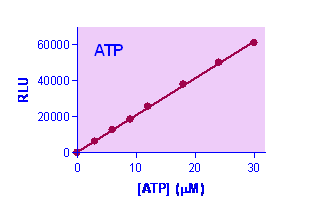
ATP测试盒
产品名称: ATP测试盒
英文名称: EnzyLight™ ATP Assay Kit
产品编号: EATP-048, EATP-100
产品价格: 0
产品产地: 美国
品牌商标: BioAssay Systems(美国博世)
更新时间: null
使用范围: null
- 联系人 :
- 地址 : 成都市新都区泰兴普河工业园105号
- 邮编 :
- 所在区域 : 四川
- 电话 : 点击查看
- 传真 : 点击查看
- 邮箱 : support@basbioinc.com
|
Description Adenosine 5-triphosphate (ATP) is the chemical energy for cellular metabolism and is often referred to as “energy currency" of the cell. ATP is produced only in living cells during photosynthesis and cellular respiration and consumed in cellular processes including biosynthetic reactions, motility and cell division. It is a key indicator of cellular activity and has been utilized as a measure of cell viability and cytotoxicity in research and drug discovery. BioAssay Systems’ EnzyLightTM ATP Assay Kit provides a rapid method to measure intracellular ATP. The single working reagent lyses cells to release ATP, which, in the presence of luciferase, immediately reacts with the Substrate D-luciferin to produce light. The light intensity is a direct measure of intracellular ATP concentration. Luciferase
This non-radioactive, homogeneous cell-based assay is performed in microplates. The reagent is compatible with all culture media and with all liquid handling systems for high-throughput screening applications in 96-well and 384-well plates.
Key features Safe. Non-radioactive assay. Sensitive and accurate. As low as 0.1 mM ATP or 40 cells can be quantified. Homogeneous and convenient. "Mix-incubate-measure" type assay. No wash and reagent transfer steps are involved. Robust and amenable to HTS: Z’ factors of > 0.5 are routinely observed in 96-well and 384-well plates. Can be readily automated on HTS liquid handling systems for processing thousands of samples per day.
Applications ATP determination in cells and other biological samples.
Kit Contents
Storage conditions: store all reagents at -20°C. This kit is shipped on dry ice. Shelf life: 6 months after receipt.
Precautions: reagents are for research use only. Normal precautions for laboratory reagents should be exercised while using the reagents. Please refer to Material Safety Data Sheet for detailed information.
Assay Procedure 1. Standard Curve. Prepare 1000 mL 30 mM ATP Premix by mixing 10 mL 3 mM Standard and 990 mL distilled water (for cell culture samples dilute ATP in culture media). Dilute standard as follows. Transfer 100 mL standards into wells of a white opaque 96-well plate.
|
|
Samples. Add 100 mL sample per well in separate wells. For tissue samples, homogenize 20 mg sample in 200 μL of cold phosphate-buffered saline, spin at 12,000 g for 5 min to pellet any debris. Transfer 1-100 μL supernatant to each well and bring the volume to 100 μL with PBS. Test several doses of the sample and choose the readings that are within the standard curve range for ATP calculation. For cell cultures, plate cells (100 mL/96well plate, 25 mL/384well plate) in white opaque tissue culture plates. If desired, add 5 mL test compounds and controls dissolved in PBS or culture medium per well. Rock plate lightly to mix and incubate for desired period of time (e.g. overnight). 2. Assay. Bring Assay Buffer and Substrate to room temperature. Thaw enzyme on ice or at 4°C. Fresh Reconstitution is recommended. Store unused reagents including the enzyme at -20°C. For each 96-well, mix 95 μL Assay Buffer with 1 μL Substrate and 1 μL ATP Enzyme. Add 90 μL Reconstituted Reagent to each well. For each 384-well, mix 30 μL Assay Buffer with 0.3 μL Substrate and 0.3 μL ATP Enzyme. Add 25 μL Reconstituted Reagent to each well. Mix by tapping the plate. Incubate for 10 minutes at room temperature. 3. Read luminescence on a luminometer. For most luminometers (Berthold Luminometer, LJL Analyst, Top Count, MicroBeta Counters, CLIPR and LeadSeeker), integration time of 0.1 to 5 sec is appropriate. General considerations Signal stability. After adding the Reconstituted Reagent, the luminescence signal is stable for about 20 min and decreases slowly thereafter.
ATP Standard Curve in Water
TUNEology 波长可调检测卡盒-->
|

